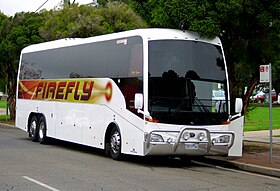Scania 4-series (bus)
| Scania 4-series | |
|---|---|

Firefly Express Coach Concepts bodied Scania K124EB in Australia
|
|
| Overview | |
| Manufacturer | Scania |
| Also called | F94, K94, K114, K124, L94, N94 |
| Assembly |
|
| Body and chassis | |
| Doors | 1 to 4 doors |
| Floor type |
Low floor Step entrance |
| Powertrain | |
| Engine | |
| Power output | 220-420 hp |
| Transmission | Scania manual or ZF automatic |
| Chronology | |
| Predecessor | Scania 3-series |
| Successor | |
The Scania 4-series low floor city bus and coach range was introduced by Scania in 1997 as a successor to the 3-series bus range.
The 4-series bus range was first presented in September 1996, when the integral low-floor city bus OmniCity was revealed. Production of the chassis range started in second half of 1997, and by the end of 1998 all worldwide production facilities had changed from 3-series to 4-series. Unlike the 3-series, which was a range of 45 different chassis models, the 4-series is one basic chassis with different modular configurations depending on usage and customer needs. At launch there were a total of seven major configurations, presumably the F HB, K EB, K IB, L IB, L UB, N UA and N UB. These were later followed by the F HA, K UB, L IA, L UA and N UD. The first letter describing the position of the engine, and the last two letters describing areas of use. In marketing of the 4-series, Scania have generally only used the engine position (F/K/L/N), the engine displacement (9/11/12) and the series number (4), which is why we know them as F94, F114, K94, K114, K124, L94 and N94.
The 4-series was superseded in 2006 by the new Euro IV compliant bus and coach range consisting of the K-series, N-series and F-series. Some 4-series products have been available for a couple of years after this.
Approximation of the power rating in hp to the nearest ten.
Engines available at launch were the 9.0-litre (8974 cc) DSC9 and the 11.7-litre (11705 cc) DSC12, both being Euro II compliant inline 6-cylinder, turbocharged and intercooled engines. The DSC9 with outputs at 220 hp (1005 Nm), 260 hp (1180 Nm) and 310 hp (1355 Nm), and the DSC12 with outputs at 360 hp (1665 Nm) and 420 hp (1950 Nm).
In November 1999, Scania presented a new range of Euro III compliant truck engines, which soon became available on the buses too. The DSC9 and the DSC12 were renamed DC9 and DC12, and new power outputs were 230 hp (1100 Nm), 260 hp (1250 Nm) and 300 hp (1400 Nm) for the DC9 and 420 hp (2000 Nm) for the DC12. To fill the gap between them, they were joined by the new 10.6-litre (10641 cc) DC11 engine with power outputs at 340 hp (1600 Nm) and 380 hp (1800 Nm).
...
Wikipedia
